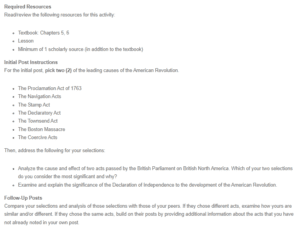Discussion – The American Revolution
The Stamp Act saw the American colonists taxed with duties by Parliament, which were associated with commerce and trade. The Stamp Act was different in that while it had a minor effect on the gentry, it was a significant burden on the less wealthy. For example, Virginia, which used courts in debt collection, would face higher costs following the Stamp Act. The Act set a precedent for a legal system that relied on precedents where the colonists were left to feel that they had no power over their own legislation. The coordinated resistance against the Stamp Act was the beginning of the soon-to-manifest Revolution (OpenStax, 2019).
The Coercive/Intolerable Acts, on the other hand, took the rights and self-governance of Massachusetts. These Acts triggered indignation and outrage in 13 Colonies and were the main developments leading to the 1775 American Revolutionary War. The Coercive Acts were viewed as a direct violation of the natural and constitutional rights of Americans. Many colonists viewed the Intolerable Acts as a threat to Americans living in Massachusetts as well as to the rest of British America (OpenStax, 2019). The Acts were described as the ‘most wicked’ form of destroying American liberties (Ammerman, 1974)
The Coercive Acts, in my opinion, were most significant because they propelled the colonists to take action against the oppression by the British Empire. Instead of cowing Massachusetts and separating the state from the rest, the Coercive Acts became the reason for convening the First Continental Congress. The Congress precipitated the drive to start the American Revolutionary War the following year. Hence, the Coercive Acts were the last stroke that broke America’s back and brought much-needed independence from colonial rule.
The Declaration of Independence led to American independence from British rule. The Declaration gave the US the right to revolt against a government that violated its natural rights while helping the US get French foreign assistance in fighting against the British. Additionally, the Declaration stated that ideals such as equality and liberty were essential for every person and by also listed all that was unacceptable (such as interference with state legislation).
References
Ammerman, David Leon (1974). In the Common Cause: American Response to the Coercive Acts of 1774. New York: University Press of Virginia. pp. 170. doi:10.1080/03612759.1975.9946789. ISBN 9780813905259. OCLC 1551470.
Corbett, P. S., Volker, J., Lund, J. M., Phannestiel, T., Waskiewicz, S., & Vickery, P. (2014). U.S. history. Houston,TX: OpenStax.
OpenStax. (2019). U.S. history. OpenStax CNX. Retrieved from https://cnx.org/contents/[email protected]:gMXC1GEM@7/Introduction
ORDER A PLAGIARISM-FREE PAPER HERE
We’ll write everything from scratch
Question

Discussion – The American Revolution
Required Resources
Read/review the following resources for this activity:
- Textbook: Chapters 5, 6
- Lesson
- Minimum of 1 scholarly source (in addition to the textbook)
Initial Post Instructions
For the initial post, pick two (2) of the leading causes of the American Revolution.
- The Proclamation Act of 1763
- The Navigation Acts
- The Stamp Act
- The Declaratory Act
- The Townsend Act
- The Boston Massacre
- The Coercive Acts
Then, address the following for your selections:
- Analyze the cause and effect of two acts passed by the British Parliament on British North America. Which of your two selections do you consider the most significant and why?
- Examine and explain the significance of the Declaration of Independence to the development of the American Revolution.
Follow-Up Posts
Compare your selections and analysis of those selections with those of your peers. If they chose different acts, examine how yours are similar and/or different. If they chose the same acts, build on their posts by providing additional information about the acts that you have not already noted in your own post.

